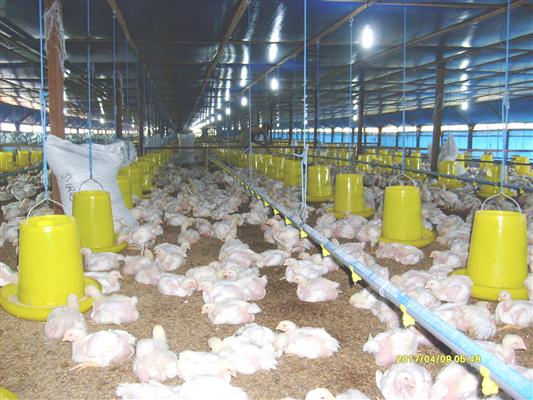|
pii: S2322455X1400005-4
Prevalence and Pathology of egg bound syndrome in commercial white leghorn chicken

|
Original Article, D5
Srinivasan P., Balasubramaniam G.A., Gopala Krishna Murthy T.R. and Balachandran P.
J. World's Poult. Res. 4(2): 30-36, 2014
ABSTRACT: Prevalence of egg bound syndrome in commercial white leghorn layer chicken in Namakkal region of India was studied over a period of two years from June 2009 to May 2011. Out of 24,158 carcasses examined, the egg bound syndrome was noticed in 663 cases with a overall mortality of 0.5 %. The study revealed that heat stress (28.66%), asphyxia (23.23%), hypocalcemia (17.35%), salpingitis (7.54%), large size egg (6.18%), dehydration (5.73%), vent trauma (5.28%), obesity (3.62%), abnormal ovulation (1.81%) and oviduct neoplasm (0.60%) were the various causes of egg bound syndrome in commercial layer chicken. Microbial analysis of the samples revealed the presence of Escherichia coli from cases associated with salpingitis. The syndrome was recorded with highest occurrence in 21-30 wk and 61-70 wk age laying chicken and with a higher incidence in summer season (44.95%).
Keywords: Layer chicken, Prevalence, Egg bound
|

|
|
pii: S2322455X1400006-4
Chicken by the Sea: The Differential Impact of Ecology and Socio-Economics on the Evolution of Value Chains for Chicken in Japan and Peru

|
Original Article, D6
Shimizu T and Scott GJ.
J. World's Poult. Res. 4(2): 37-47, 2014
ABSTRACT: Chicken demand and supply has increased in many developing countries in the last few decades. Peru is one of those countries. When we analyze the increase in Peru since the 1990s, compared with the case of Japan between the 1960s and 1980s in which demand and supply also increased, we find common factors such as the development of intensive agriculture that depends on imported feed grains. However, because of several distinguishing ecological and socio-economic factors, the development of the value chain for chicken in Peru has been different from Japan, especially in the integration of further food processing and handling in chain activities.
Keywords: Broilers, Integration, Processing, Relative Prices, Economic Growth
|

|
|
pii: S2322455X1400007-4
Effect of Dietary Levels of High Pressure Steam Native Lablab purpureus (L) sweet on Broiler Performance

|
Original Article, D7
Ludfi M, Sudjarwo E, Sjofjan O.
J. World's Poult. Res. 4(2): 48-51, 2014
ABSTRACT: Lablab purpureus (L) sweet was origin planted on east java province, Indonesia. The native name is komak beans. It has high protein (30% -33%), but the inclusion is limited caused by anti-nutrition factors such as tannin, phytic acid, and anti-trypsin. Anti-nutrition substances interfere with metabolism and protein synthesis in intestinal tract. Komak beans were processed with high pressure steam (2 atm; 121 0C; 20 min) and called Komak Beans Meal (KBM). This study focused on replacing Soybeans Meal (SBM) based diet using uplift level until totally replaced with KBM. The study designated for 100 birds one-day old Cobb strain. Raising period was 5 weeks. The treatments were: Control (Basal diet); 25 % KBM replacement; 50 % KBM replacement; 75 % KBM replacement and 100 % KBM replacement. Data were analyzed using analysis of variance (ANOVA). The results showed that 25% KBM replacement was not significantly different with control and could increase 1.04 % feed consumption; 1.23 % body weights gain, 0.97 % production index and decreased feed conversion rate (0.73 %). High pressure steam KBM process had been effective in decreasing anti-nutrition effect and didn’t cause abnormalities on broiler production performance. It could improve the broiler production performance at level of 25% KBM inclusion replacement.
Keywords: Komak beans, Broiler, Performances
|

|
|
pii: S2322455X1400008-4
Effects of Color Lights on Performance, Immune Response and Hematological Indices of Broilers

|
Original Article, D8
Firouzi S, Haghbin NazarpakH, Habibi H, Jalali SS, Nabizadeh Y, Rezaee F, Ardali R, Marzban M.
J. World's Poult. Res. 4(2): 52-55, 2014
ABSTRACT: Many studies have been shown the effects of light wave length on broilers performance in experimental assay, but we decided to evaluate the effects of different color lights on broiler performance, immune response and hematological parameters in filed study. For this purpose, 40000 day-old broiler chickens were placed in four houses as follow: green, sunny yellow, blue and red light. All light sources were equalized at the intensity of 25 lux, with light period of 23 hours daily. In days 8, 18, 30 and 42 from each house, 25 samples of serum were obtained to evaluate the ND-antibody responses. At 42 days of age, 25 blood samples were taken from each house to evaluate HDL, LDL, VLDL, triglyceride, cholesterol, total protein, creatinine, BUN and glucose of serum. The live body weight and feed intake were recorded weekly and Feed Conversion Ratio (FCR) was calculated. The results indicated that the birds reared under yellow and blue light had the best and weakest performance, respectively. The decrease of maternal antibody in group which reared under green light was the slowest and at the end of experiment the birds which were exposed to green and blue light had the highest ND antibody titers among all groups but it was insignificant (P>0.05). The birds in yellow light house showed a significant increase in total serum protein (P0.05).
Keywords: Light Color, Performance, Immune Response, Hematological Indices, Broiler.
|

|